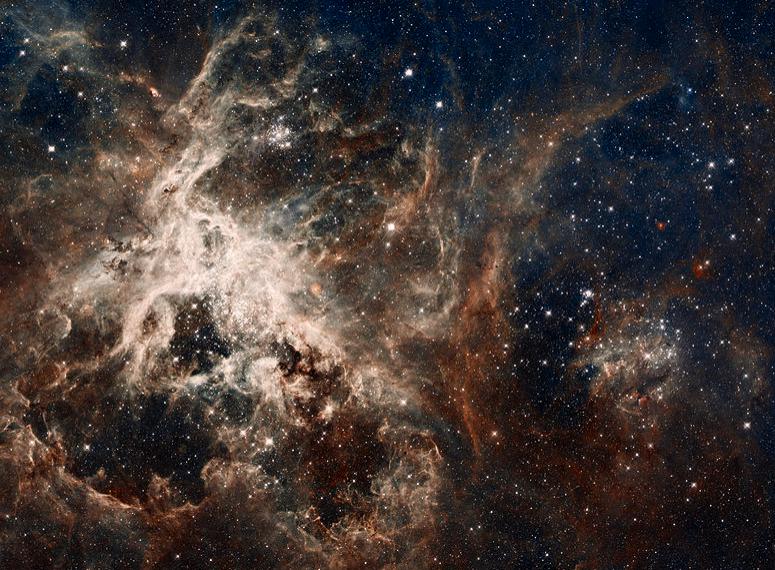Astronomy
 The Tarantula Nebula, also known as 30 Doradus is a giant star-forming region, where energy from hot and young stars creates dramatic voids and filaments surrounding by gas. It is located in the Large Magellanic Cloud [LMC] galaxy at a distance of 160,000 light-years to Earth.
The Tarantula Nebula, also known as 30 Doradus is a giant star-forming region, where energy from hot and young stars creates dramatic voids and filaments surrounding by gas. It is located in the Large Magellanic Cloud [LMC] galaxy at a distance of 160,000 light-years to Earth.
Considering its distance, this is an extremely luminous non-stellar object. Its luminosity is so great that if it were as close to Earth as the Orion Nebula, the Tarantula Nebula would cast shadows. In fact it is the most active starburst region known in the Local Group of galaxies.
Tarantula Nebula has in its centre the star cluster NGC 2070 which includes the compact concentration of stars known as R136 that produces most of the energy that makes the nebula visible. The estimated mass of the cluster is 450,000 solar masses, suggesting it will likely become a globular cluster in the future.
source:- wikipedia
- The Pacman Nebula.
NGC 281 is an H II region, located about 9,200 light years from Earth in the constellation of Cassiopeia. It is also known as the Pacman Nebula for its resemblance to the video game character. It includes an open cluster IC 1590 and the...
- The Large Magellanic Cloud
Large Magellanic Cloud [LMC] is the third nearest galaxy to the Milky Way at a distance of 163,000 light-years. It has a diameter of about 14,000 light years and a mass of approximately 10 billion Suns, making it roughly 1/100 as massive as...
- The Fox Nebula
Fox Fur Nebula is located in NGC 2264 Region and lies in the constellation of Monoceros.This interstellar beast is formed of cosmic dust and gas interacting with the energetic light and winds from hot young stars. The shape, visual texture,...
- The Rosette Nebula In Monoceros In Ha
The Rosette Nebula with NGC 2244 star cluster in its middle is beautiful. The mass of the nebula is estimated to be around 10,000 solar masses. The cluster and nebula lie at a distance of some 5,200 LY from Earth and measure roughly 130 LY in diameter....
- Messier Objects
Messier Objects ...
Astronomy
The Tarantula Nebula.

Considering its distance, this is an extremely luminous non-stellar object. Its luminosity is so great that if it were as close to Earth as the Orion Nebula, the Tarantula Nebula would cast shadows. In fact it is the most active starburst region known in the Local Group of galaxies.
Tarantula Nebula has in its centre the star cluster NGC 2070 which includes the compact concentration of stars known as R136 that produces most of the energy that makes the nebula visible. The estimated mass of the cluster is 450,000 solar masses, suggesting it will likely become a globular cluster in the future.
source:- wikipedia
- The Pacman Nebula.
NGC 281 is an H II region, located about 9,200 light years from Earth in the constellation of Cassiopeia. It is also known as the Pacman Nebula for its resemblance to the video game character. It includes an open cluster IC 1590 and the...
- The Large Magellanic Cloud
Large Magellanic Cloud [LMC] is the third nearest galaxy to the Milky Way at a distance of 163,000 light-years. It has a diameter of about 14,000 light years and a mass of approximately 10 billion Suns, making it roughly 1/100 as massive as...
- The Fox Nebula
Fox Fur Nebula is located in NGC 2264 Region and lies in the constellation of Monoceros.This interstellar beast is formed of cosmic dust and gas interacting with the energetic light and winds from hot young stars. The shape, visual texture,...
- The Rosette Nebula In Monoceros In Ha
The Rosette Nebula with NGC 2244 star cluster in its middle is beautiful. The mass of the nebula is estimated to be around 10,000 solar masses. The cluster and nebula lie at a distance of some 5,200 LY from Earth and measure roughly 130 LY in diameter....
- Messier Objects
Messier Objects ...
